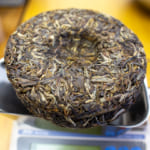- HOME >
- How to enjoy tea
Introduction to Easy Tea Brewing Methods
- [2023.06.24] Posted By Akira Hojo

Many people might find themselves without the necessary tools or knowledge to brew tea, despite having acquired the tea itself.
Of course, if one aims to achieve the perfect flavor and aroma, using traditional tea utensils such as a Gaiwan or a teapot would be ideal.
However, there are situations where a perfect brewing method is not always necessary. For example, when drinking tea during work or when looking for a convenient option, knowing a simplified brewing method can be quite useful.
In this article, I would like to introduce a method for brewing tea quickly and easily, even in busy or tool-lacking situations.
Brewing tea directly in a glass or a mug
All you need is a glass or a mug for this method.
First, preheat the container by pouring boiling water into it, filling it about 80% full. Let it sit for 10 seconds, then discard the water.
Next, add around 2 grams of tea leaves to the container and pour boiling water over them. Let it steep for 1-2 minutes. As the tea leaves infuse into the water, they will start to sink to the bottom.
Initially, you may notice a few tea leaves floating, but try to avoid them as you drink. As you continue to drink, most of the tea leaves will settle at the bottom.
After finishing a cup, you can pour hot water into the container again and continue brewing for 2-3 more cups, not just one.
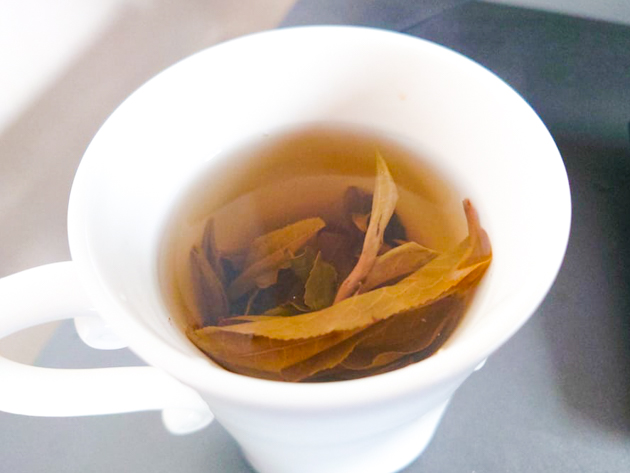
This method allows you to observe the tea leaves unfurling, making it a surprisingly enjoyable way to drink tea.

Oolong Tea: Immediately after pouring hot water (as shown in the top picture), the tea leaves may float slightly, but as they infuse into the water, they will begin to sink and reach a state similar to the picture below. It is important not to add too many tea leaves as Oolong tea leaves tend to unfurl significantly.


Interestingly, this brewing method is the most widely practiced way of drinking tea in China.
Chinese Tea is Not Powdery
In the case of Chinese and Taiwanese teas, the tea leaves are hand-picked and processed to retain their original shape.
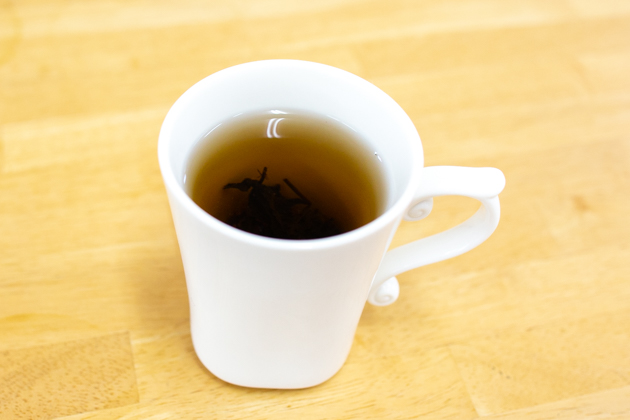
As a result, it is rare for the tea leaves to float on the water’s surface, and once the water infuses, the tea leaves will eventually sink to the bottom.
Even with Japanese teas, such as lightly steamed teas processed to preserve their shape, you can use this method to brew them.
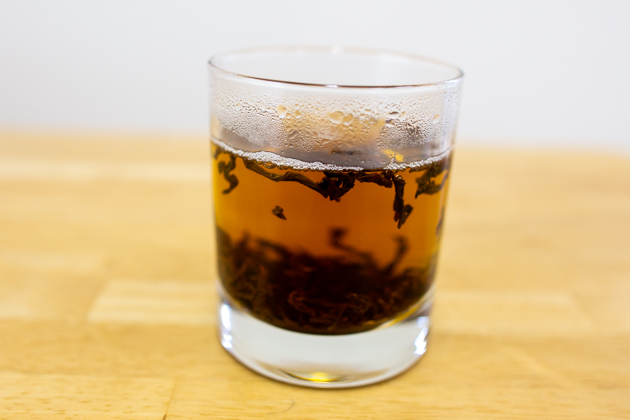
Black tea can also be brewed in a glass or a mug. Immediately after adding hot water, you may notice some tea leaves floating, but they will quickly sink to the bottom.

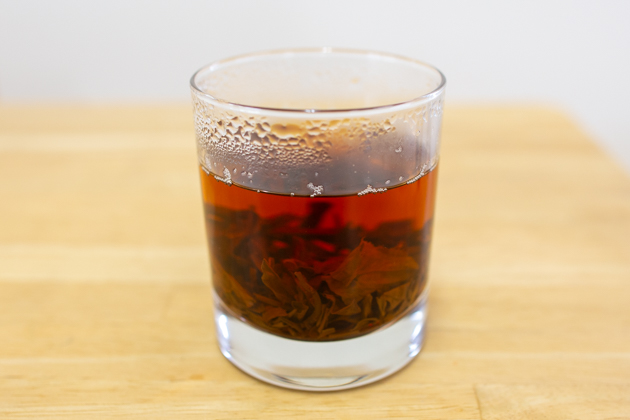
It is usually not a problem to use non-heat-resistant glass
Many people may believe that if a glass is not heat-resistant, it will break when hot water is poured into it. In fact, if you look at the websites of glass manufacturers, you may find warnings that pouring boiling water into non-heat-resistant glass can cause it to break.
However, based on my experience, I have never had a non-heat-resistant glass break. (Please note that this is my personal experience, and I have poured boiling water into various types of glasses hundreds of times without any breakage.)
Of course, if you pour boiling water into a glass that is already very cold, such as in winter, it may break.
If you have concerns, it is safer to preheat the glass with lukewarm water or water at around 60°C to reduce the temperature difference before using it with boiling water.
Related Articles
How to get the latest update on HOJO?
1. Follow Twitter, 2. Click "Like" on Facebook, and 3. Subscribe in newsletter. You can have the latest tea news from HOJO.
 Subscribe the Newsletter to enjoy the privileges
Subscribe the Newsletter to enjoy the privileges- You may receive a free sample upon purchase, or you may have the priority to purchase special products. So please remember to subscribe our newsletter as well as the social network.
- New Arrival of Akitsu Mumyoi and Nosaka Rough Clay Teapot
- A wide selection of teaware by Watanabe Tozo, a Sado-based artist of Mumyoi-yaki, has just arrived. This time, …
- Mang Fei Ripe Pu-erh Tea 2023 – Small-Batch Production from a Renowned Region
- Mang Fei Ripe Pu-erh Tea 2023 is now available. This is one of the highest-quality ripe pu-erh teas among our …
NEW ARTICLES
 Development of Firewood Roasted Hojicha Using Naturally Grown Tea from Yunnan
Development of Firewood Roasted Hojicha Using Naturally Grown Tea from Yunnan- We are currently staying in Yunnan Province for tea production. As the season nears its end, tea trees with pa …
 Exploring the Food Culture of Yunnan: Where Minority and Sichuan Cuisines Meet
Exploring the Food Culture of Yunnan: Where Minority and Sichuan Cuisines Meet- We are currently staying long-term in Yunnan Province for spring tea production. On rainy days or when there i …
 New Arrival of Akitsu Mumyoi and Nosaka Rough Clay Teapot
New Arrival of Akitsu Mumyoi and Nosaka Rough Clay Teapot- A wide selection of teaware by Watanabe Tozo, a Sado-based artist of Mumyoi-yaki, has just arrived. This time, …
 Managing Yunnan White Tea — Insights from the Field
Managing Yunnan White Tea — Insights from the Field- Since March 25, we have been in Yunnan Province, fully engaged in the production of white tea. In this column, …
 Mang Fei Ripe Pu-erh Tea 2023 – Small-Batch Production from a Renowned Region
Mang Fei Ripe Pu-erh Tea 2023 – Small-Batch Production from a Renowned Region- Mang Fei Ripe Pu-erh Tea 2023 is now available. This is one of the highest-quality ripe pu-erh teas among our …
 Yunnan Tea Trends 2025: Insights from the Fields
Yunnan Tea Trends 2025: Insights from the Fields- Since March 25, we have been in Yunnan Province. We will stay here until May to conduct tea production, packin …
 Why Do Some Teas Taste Astringent? Exploring the Causes and Mechanisms of Astringency
Why Do Some Teas Taste Astringent? Exploring the Causes and Mechanisms of Astringency- Tea can range from having no noticeable astringency to possessing a very strong one. What causes this astringe …
 The Impact of Heat Sources on Tea Flavor
The Impact of Heat Sources on Tea Flavor- It is widely recognized that the material of a kettle plays an important role in shaping the taste of water fo …
 New Release of Tang Li Shan Ripe Pu-erh Tea 2023
New Release of Tang Li Shan Ripe Pu-erh Tea 2023- We have released the 2023 edition of Tang Li Shan Ripe Pu-erh Tea. Tang Li Shan refers to a mountain located o …
 The New Release of Dong Shan Raw Pu-erh Tea 2023 and Jasmine Silver Needle
The New Release of Dong Shan Raw Pu-erh Tea 2023 and Jasmine Silver Needle- We have released Dong Shan Raw Pu-erh Tea 2023 and Jasmine Silver Needle. Dong Shan Raw Pu-erh Tea 2023 We hav …
Category
- New Arrival at HOJO Online Shop
- Featured Articles
- Newsletter
- Types of Tea
- Origin of Tea
- Teapot and Tea Equipment
- Tea Column
- How to enjoy tea
- Tea Processing
- How to choose quality tea
- Tea constituents and functional effect
- Safety of Tea
- Foods
- Tea Business Operation
- Hobby and Outdoor Activity
- Ranking of Tea
- Video
- FAQ
- Media Release
Profile

- AKIRA HOJO
- I invite you to experience my tea selections.I was born in Nagano, Japan. In university, I studied agricultural chemistry, and I have the master degree in food science. I worked in Japanese food industry for 10 years. I involved in R&D, QC and QA. As a factory manager, I implemented ISO9000 series and managed the factory.
- The Art of Tea Magazine
- We posted the article on “The Art of Tea Magazine No.9, the magazine is published in Taiwan. We featured …
- New Straits Times
- The Malaysian National Newspaper, New Straits Times featured HOJO Tea on 17-Oct-2007.
Shop Info

Address:Lot No. T-215, 3rd Floor, The Gardens Mall, Mid Valley City, Lingkaran Syed Putra, 59200 Kuala Lumpur
Tel: +603-2287-4537
Business Hour: 10am to 10pm












